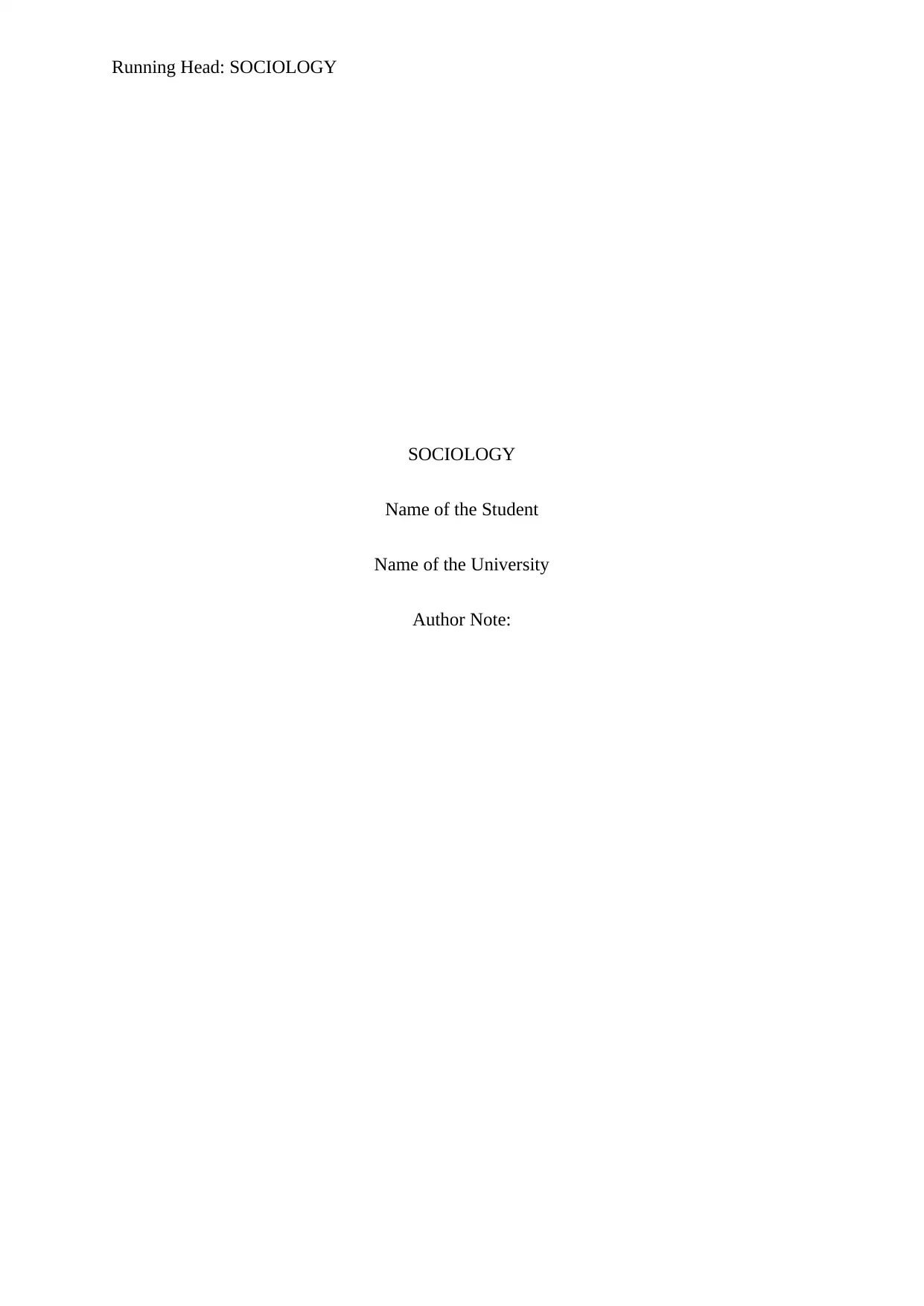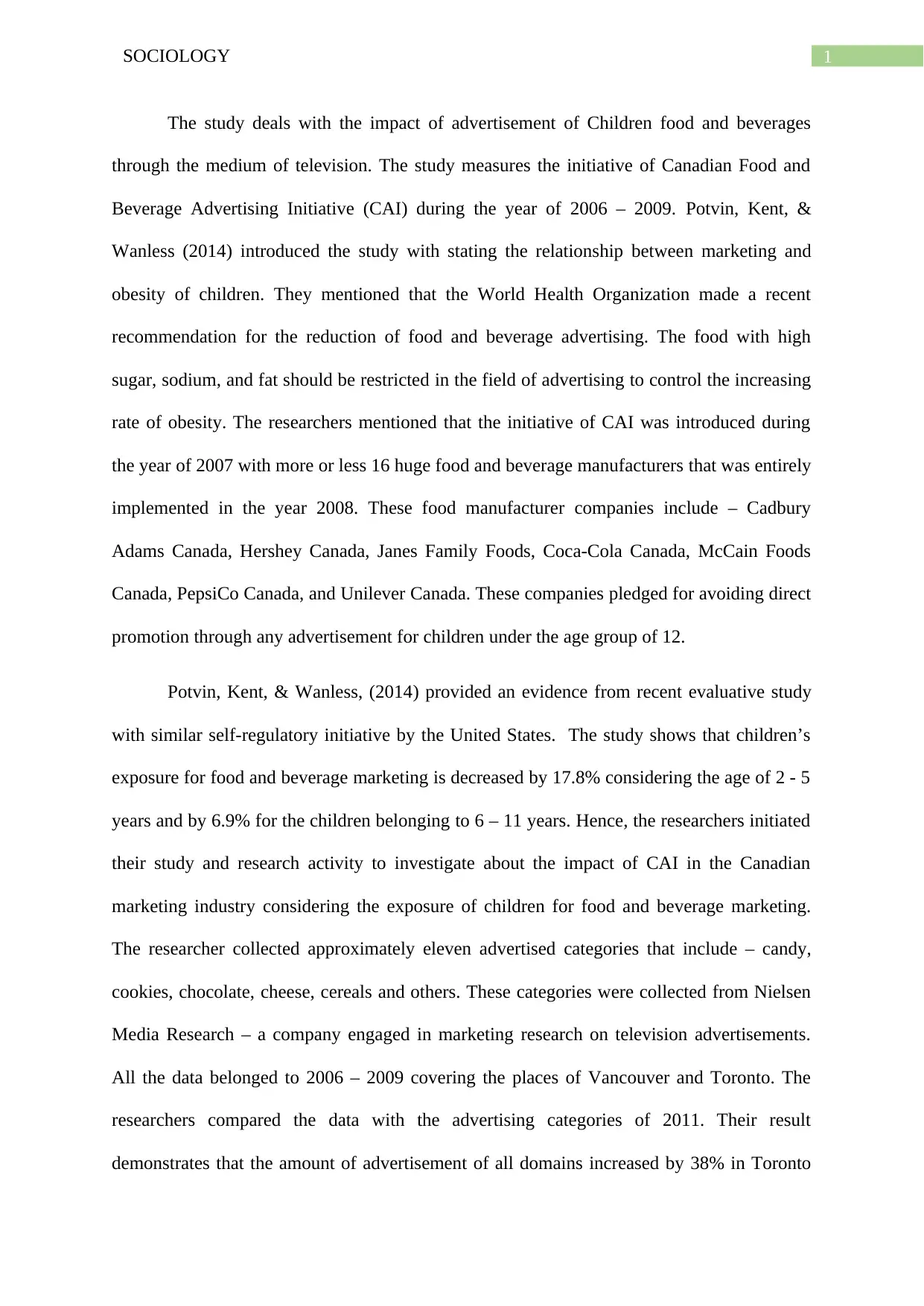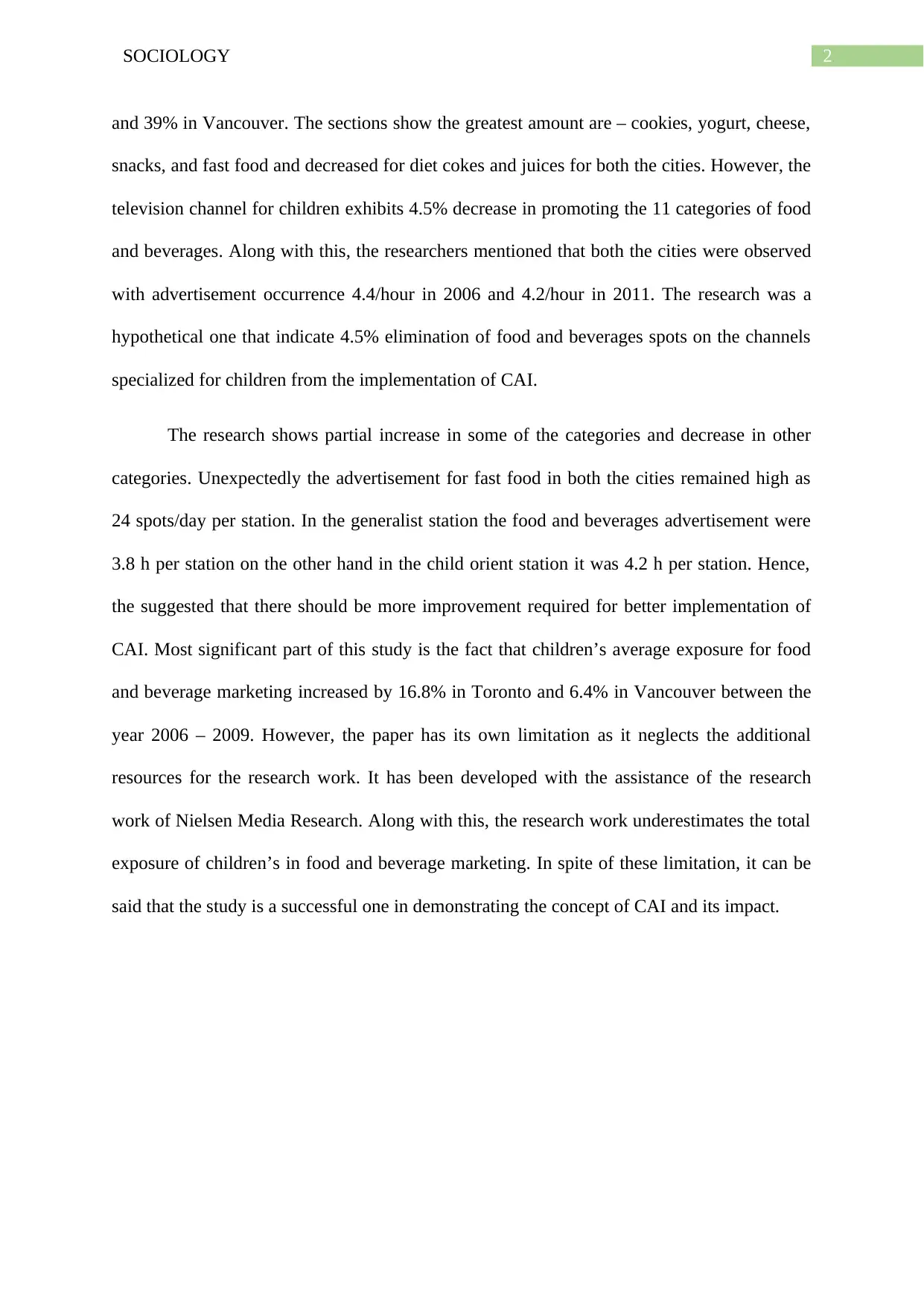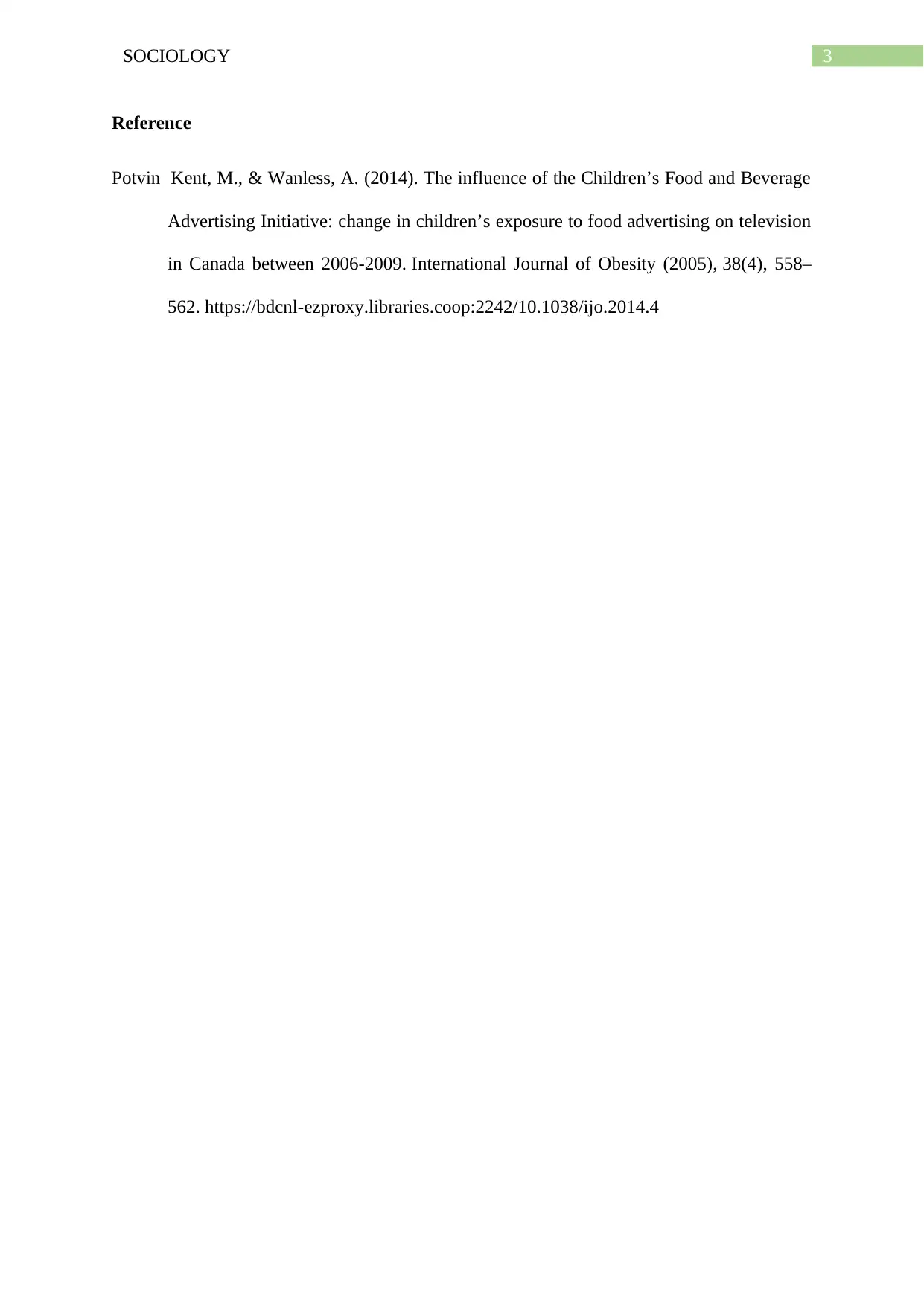Sociology Research paper 2022
VerifiedAdded on 2022/09/18
|4
|773
|41
AI Summary
Contribute Materials
Your contribution can guide someone’s learning journey. Share your
documents today.

Running Head: SOCIOLOGY
SOCIOLOGY
Name of the Student
Name of the University
Author Note:
SOCIOLOGY
Name of the Student
Name of the University
Author Note:
Secure Best Marks with AI Grader
Need help grading? Try our AI Grader for instant feedback on your assignments.

1SOCIOLOGY
The study deals with the impact of advertisement of Children food and beverages
through the medium of television. The study measures the initiative of Canadian Food and
Beverage Advertising Initiative (CAI) during the year of 2006 – 2009. Potvin, Kent, &
Wanless (2014) introduced the study with stating the relationship between marketing and
obesity of children. They mentioned that the World Health Organization made a recent
recommendation for the reduction of food and beverage advertising. The food with high
sugar, sodium, and fat should be restricted in the field of advertising to control the increasing
rate of obesity. The researchers mentioned that the initiative of CAI was introduced during
the year of 2007 with more or less 16 huge food and beverage manufacturers that was entirely
implemented in the year 2008. These food manufacturer companies include – Cadbury
Adams Canada, Hershey Canada, Janes Family Foods, Coca-Cola Canada, McCain Foods
Canada, PepsiCo Canada, and Unilever Canada. These companies pledged for avoiding direct
promotion through any advertisement for children under the age group of 12.
Potvin, Kent, & Wanless, (2014) provided an evidence from recent evaluative study
with similar self-regulatory initiative by the United States. The study shows that children’s
exposure for food and beverage marketing is decreased by 17.8% considering the age of 2 - 5
years and by 6.9% for the children belonging to 6 – 11 years. Hence, the researchers initiated
their study and research activity to investigate about the impact of CAI in the Canadian
marketing industry considering the exposure of children for food and beverage marketing.
The researcher collected approximately eleven advertised categories that include – candy,
cookies, chocolate, cheese, cereals and others. These categories were collected from Nielsen
Media Research – a company engaged in marketing research on television advertisements.
All the data belonged to 2006 – 2009 covering the places of Vancouver and Toronto. The
researchers compared the data with the advertising categories of 2011. Their result
demonstrates that the amount of advertisement of all domains increased by 38% in Toronto
The study deals with the impact of advertisement of Children food and beverages
through the medium of television. The study measures the initiative of Canadian Food and
Beverage Advertising Initiative (CAI) during the year of 2006 – 2009. Potvin, Kent, &
Wanless (2014) introduced the study with stating the relationship between marketing and
obesity of children. They mentioned that the World Health Organization made a recent
recommendation for the reduction of food and beverage advertising. The food with high
sugar, sodium, and fat should be restricted in the field of advertising to control the increasing
rate of obesity. The researchers mentioned that the initiative of CAI was introduced during
the year of 2007 with more or less 16 huge food and beverage manufacturers that was entirely
implemented in the year 2008. These food manufacturer companies include – Cadbury
Adams Canada, Hershey Canada, Janes Family Foods, Coca-Cola Canada, McCain Foods
Canada, PepsiCo Canada, and Unilever Canada. These companies pledged for avoiding direct
promotion through any advertisement for children under the age group of 12.
Potvin, Kent, & Wanless, (2014) provided an evidence from recent evaluative study
with similar self-regulatory initiative by the United States. The study shows that children’s
exposure for food and beverage marketing is decreased by 17.8% considering the age of 2 - 5
years and by 6.9% for the children belonging to 6 – 11 years. Hence, the researchers initiated
their study and research activity to investigate about the impact of CAI in the Canadian
marketing industry considering the exposure of children for food and beverage marketing.
The researcher collected approximately eleven advertised categories that include – candy,
cookies, chocolate, cheese, cereals and others. These categories were collected from Nielsen
Media Research – a company engaged in marketing research on television advertisements.
All the data belonged to 2006 – 2009 covering the places of Vancouver and Toronto. The
researchers compared the data with the advertising categories of 2011. Their result
demonstrates that the amount of advertisement of all domains increased by 38% in Toronto

2SOCIOLOGY
and 39% in Vancouver. The sections show the greatest amount are – cookies, yogurt, cheese,
snacks, and fast food and decreased for diet cokes and juices for both the cities. However, the
television channel for children exhibits 4.5% decrease in promoting the 11 categories of food
and beverages. Along with this, the researchers mentioned that both the cities were observed
with advertisement occurrence 4.4/hour in 2006 and 4.2/hour in 2011. The research was a
hypothetical one that indicate 4.5% elimination of food and beverages spots on the channels
specialized for children from the implementation of CAI.
The research shows partial increase in some of the categories and decrease in other
categories. Unexpectedly the advertisement for fast food in both the cities remained high as
24 spots/day per station. In the generalist station the food and beverages advertisement were
3.8 h per station on the other hand in the child orient station it was 4.2 h per station. Hence,
the suggested that there should be more improvement required for better implementation of
CAI. Most significant part of this study is the fact that children’s average exposure for food
and beverage marketing increased by 16.8% in Toronto and 6.4% in Vancouver between the
year 2006 – 2009. However, the paper has its own limitation as it neglects the additional
resources for the research work. It has been developed with the assistance of the research
work of Nielsen Media Research. Along with this, the research work underestimates the total
exposure of children’s in food and beverage marketing. In spite of these limitation, it can be
said that the study is a successful one in demonstrating the concept of CAI and its impact.
and 39% in Vancouver. The sections show the greatest amount are – cookies, yogurt, cheese,
snacks, and fast food and decreased for diet cokes and juices for both the cities. However, the
television channel for children exhibits 4.5% decrease in promoting the 11 categories of food
and beverages. Along with this, the researchers mentioned that both the cities were observed
with advertisement occurrence 4.4/hour in 2006 and 4.2/hour in 2011. The research was a
hypothetical one that indicate 4.5% elimination of food and beverages spots on the channels
specialized for children from the implementation of CAI.
The research shows partial increase in some of the categories and decrease in other
categories. Unexpectedly the advertisement for fast food in both the cities remained high as
24 spots/day per station. In the generalist station the food and beverages advertisement were
3.8 h per station on the other hand in the child orient station it was 4.2 h per station. Hence,
the suggested that there should be more improvement required for better implementation of
CAI. Most significant part of this study is the fact that children’s average exposure for food
and beverage marketing increased by 16.8% in Toronto and 6.4% in Vancouver between the
year 2006 – 2009. However, the paper has its own limitation as it neglects the additional
resources for the research work. It has been developed with the assistance of the research
work of Nielsen Media Research. Along with this, the research work underestimates the total
exposure of children’s in food and beverage marketing. In spite of these limitation, it can be
said that the study is a successful one in demonstrating the concept of CAI and its impact.

3SOCIOLOGY
Reference
Potvin Kent, M., & Wanless, A. (2014). The influence of the Children’s Food and Beverage
Advertising Initiative: change in children’s exposure to food advertising on television
in Canada between 2006-2009. International Journal of Obesity (2005), 38(4), 558–
562. https://bdcnl-ezproxy.libraries.coop:2242/10.1038/ijo.2014.4
Reference
Potvin Kent, M., & Wanless, A. (2014). The influence of the Children’s Food and Beverage
Advertising Initiative: change in children’s exposure to food advertising on television
in Canada between 2006-2009. International Journal of Obesity (2005), 38(4), 558–
562. https://bdcnl-ezproxy.libraries.coop:2242/10.1038/ijo.2014.4
1 out of 4
Your All-in-One AI-Powered Toolkit for Academic Success.
+13062052269
info@desklib.com
Available 24*7 on WhatsApp / Email
![[object Object]](/_next/static/media/star-bottom.7253800d.svg)
Unlock your academic potential
© 2024 | Zucol Services PVT LTD | All rights reserved.